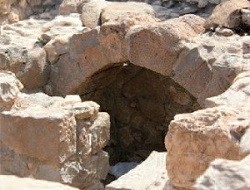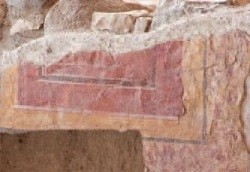The Lost Town
A lost town by the shores of Lake Kinneret is slowly revealing its important 'secrets' as archaeological excavations, which began seven years ago, continue.
The town is Magdala, near Tiberias, and earlier this year, an ESRA group visited the site where their guide was fellow ESRA member Mike Moss, who specializes in the archaeology and history of the town.
Mike gave the group a fuller picture of Magdala's entirely Jewish activities spanning a 150 year period during the 1st Century BCE and the 1st Century CE.
This timespan includes the three year period in the lives of Jesus and Mary Magdalene ('Miriam from Magdala') who are both associated with the town.
Their unrivalled links to this place evoke great interest from delighted Christian pilgrims.
Mike told the group that the town had five variations in its given name, depending on the source and the spoken language of its user.
Magdala is the Aramaic form of Migdal, mentioned in the New Testament, where Migdal, meaning 'tower' in Hebrew, is the name by which it is known in Jewish sources, including the Talmud.
The place was also known as Migdal Nuniya, which means 'the Migdal known for its fish'. Tarichaeae is Greek for 'the place of the salted fish'. This name comes down to us through the Roman Jewish historian Josephus Flavius.
And finally there is the name Dalmanutha, which is Syriac for 'the harbor' and appears in the New Testament's canonical gospel of Mark.
For decades Magdala flourished in prosperity as the most important lakeside town. It predates Tiberias by some 75 years, but was eventually eclipsed in importance by the transfer of political power to the new pro-Roman city. Nevertheless, the population of Magdala grew to many thousands until its overthrow by Roman military forces in the year 67 CE.
Magdala's principal industries were the cultivation of crops, the manufacture of olive oil, ship building and repairs, taxi-boat operations, fishing and – above all – fish processing.
In addition to salting, the townsfolk developed industrial-scale methods for smoking, drying, pickling and making Garum fish pastes and sauces.
As a major source of protein, fish products were sold in its markets as fresh produce, and the lake yielded a great abundance of kosher fish in many different species.
As a result of such skilled and varied work, the excellent quality of the preserved fish meant that demand was enormous.
Fish products were transported and sold throughout the Galil, Judea and other Roman provinces, and were also exported to Cyprus, the Greek islands – even as far as Rome.
This all made some of Magdala's residents very rich indeed.
When the First Jewish Revolt began in earnest in 66 CE, Magdala played a central role in the fighting.
The early skirmishes and final assault on the town in September 67 CE are vividly described by Josephus Flavius in his book, 'The Jewish War'. At that time he was the Jewish army's commander in the Galil.
Unfortunately, Magdala suffered a crushing defeat, and those residents who survived the Roman onslaught were forcibly taken as slaves.
Mike emphasized the importance of the remarkable fact that the town fell just three years before the fall of Jerusalem and the destruction of the Second Temple itself.
The main Roman protagonists, Vespasian and his son Titus – both in turn destined to become emperors – were personally present and active in deciding the fate of Magdala.
The town is situated in the geological confluence of the Afro-Syrian Rift, coupled with the meeting of three of the earth's tectonic plates some 20 miles below, and is built right at the foot of Mount Arbel.
As a result, over time, the land mass has been prone to instability, thermal springs, volcanic activity and earthquakes.
These features produced a phenomenon, the results of which the group was able to witness for itself.
When there is a very heavy winter rain coupled with a mud-caked mountain which is shaking as a result of unstable geological conditions, what follows is a severe and sustained mudslide.
Mike suggests this happened shortly after the Romans depopulated the town of its Jews at the end of September 67 CE.
There are no traces of any occupation or activity between 1st Century CE and the year 2009 when the excavations started.
Therefore the effect of the mudslide was to preserve the magnificent remains that are nw slowly, and ever so carefully, being unearthed.
Those present learned that this recently-revealed archaeology is unique, or at the very least, extremely rare.
The site boasts none other than the only 1st Century synagogue in the Galil, and only one of seven in the whole of Israel.
A unique carved oblong-shaped limestone block, now known worldwide as 'The Magdala Stone' was found in the center of the synagogue.
It artistically represents the 2nd Temple itself, with reliefs showing vessels for oil, water and wine, colonnades, incense tools, aspects of the showbread table, and even a chariot of fire. There is also a relief of a seven-branched menorah.
Thousands of coins spanning 150 years or so of the town, many of which are dated, have been found and, so far, three uniquely constructed mikvaot with water still filling from the springs in Mount Arbel together with rising ground water. They include covered channels for surplus water to reach the lake.
The party then went on to see the 1st Century remains of the port and harbor, roads and walls, the once-covered market, the magnificent mosaics, painted frescoes of the 2nd Pompey style, painted plaster on pillars, defensive structures from the period of the Revolt, an intact archway, fish tanks and Roman era cement more durable than our modern versions, and much much more.
According to Mike, lots more of this lost town is yet to emerge from its mud-created time capsule, which will reveal the site's importance in the spheres of faith, history and culture, which, he adds, cannot be overestimated.
In the archaeological gardens, visitors can see an excellent layout of the historical narrative and photographic representations of the discovery of the many recently-revealed buildings, and most of the 1st Century finds.
Mike and his wife, Ros, made aliyah from Leeds UK nine years ago, and they live on an agricultural moshav about 20 minutes by car from Magdala.
He is completing a book on the history and archaeology of Jewish Magdala which will be published shortly.
The Magdala site is open to visitors seven days a week from 08:00 to 18:00. Entry costs between NIS10 to NIS15.
If you would like Mike Moss to accompany you and share some of his stories, he can be reached on 053 627 6105, or email him at This email address is being protected from spambots. You need JavaScript enabled to view it.
Mike works in a voluntary capacity at the site, and there is no charge for his tours.













Comments